
What you’ll learn:
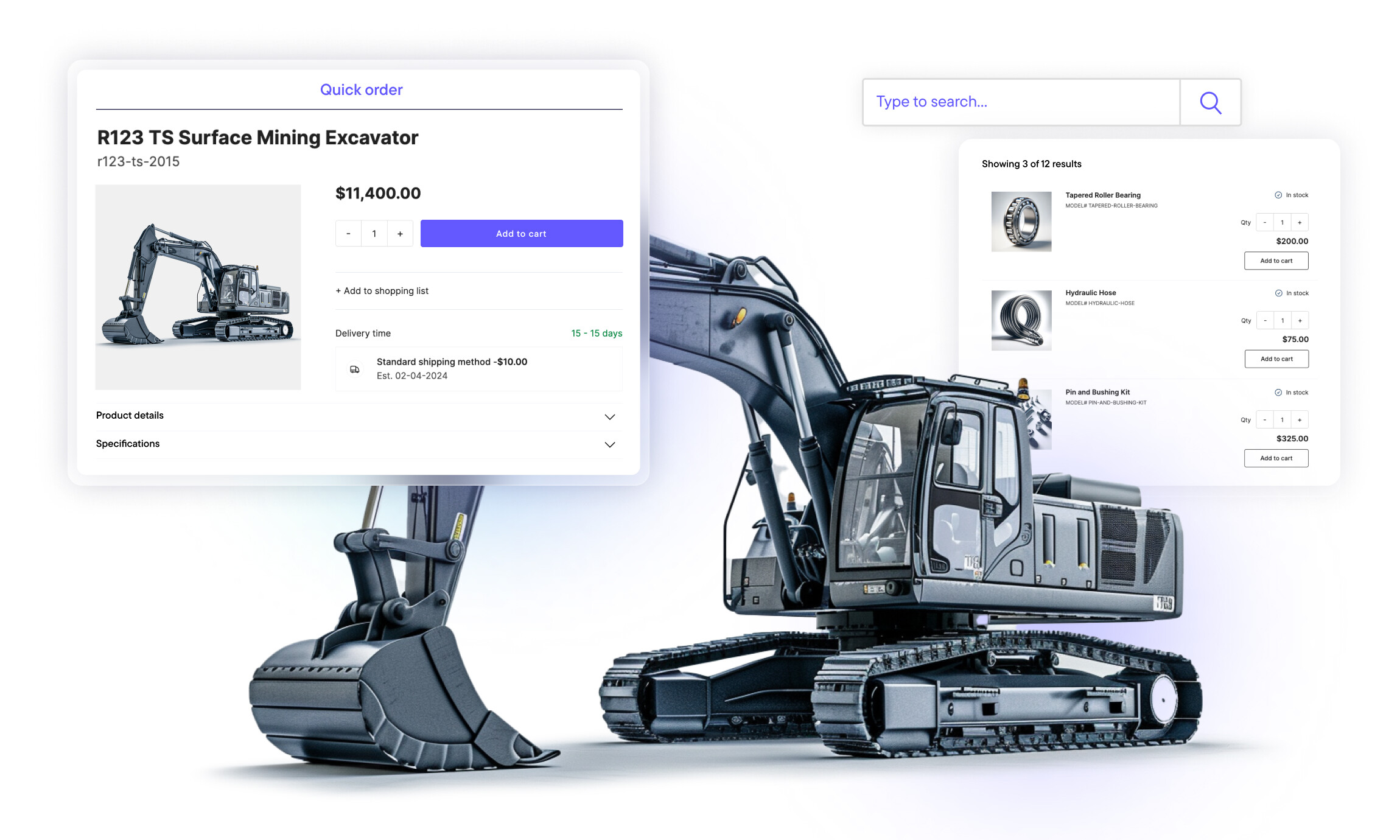
Investing in B2B Commerce for faster ROI
There’s no denying that the manufacturing industry is at a turning point when it comes to digital commerce. eMarketer reported that B2B eCommerce sales grew 10.5% YoY in 2024, reaching $2.297 trillion USD. Currently, 85% of B2B organizations have a digital storefront. Manufacturers, in particular, are investing heavily in eCommerce, with 66% of them allocating resources to invest in B2B customer portals or improve existing online experiences.
More than prioritizing investments, B2B manufacturers are feeling the pinch to accelerate time to value. Speed of implementation has become crucial to meeting the needs of existing B2B buyers, whose requirements have become increasingly digital, as well as table stakes for acquiring new B2B customers. Of course, businesses expect that those investments will bring a sizable ROI in the short to medium term.
While the business case is clear, numerous B2B organizations — especially those that have traditionally relied on manual, analog customer experiences — are facing the challenge of launching digital storefronts quickly. In many cases, developers have to code frontends from scratch, a process that can take weeks or even months. With launch timing being a critical benchmark of success, B2B manufacturers simply cannot afford the luxury of taking that much time to bring their digital storefronts to life.
The challenge is rarely limited to just one storefront. Many B2B companies serve a wide range of customer segments — from large enterprise buyers to smaller SMB accounts, and in some cases even direct-to-consumer (D2C) audiences. Each of these groups expects a tailored buying experience, with workflows, interfaces and features that match their specific needs.
Supporting this variety of selling motions requires multiple storefronts, not a single one-size-fits-all solution. Building and maintaining these frontends at scale becomes enormously complex when systems are disjointed, technologies don’t integrate smoothly or teams are forced to start from scratch each time.
The result is a scalability bottleneck: Every delay in launching or replicating storefronts translates into lost revenue opportunities. Speed, in this context, goes beyond getting online faster, as it directly drives ROI by enabling organizations to serve more segments, more effectively, without ballooning development costs.
Launching eCommerce storefronts faster: Store Launchpad for B2B Manufacturing
Manufacturers no longer have to create digital storefronts from the ground up. The Store Launchpad for B2B Manufacturing is a comprehensive, ready-to-use B2B eCommerce template populated with eCommerce data that leverages the native features of commercetools B2B Commerce and Frontend, empowering businesses to create outstanding buyer experiences faster.
By combining out-of-the-box components for faster implementation with the unparalleled flexibility to change things in the future, this Store Launchpad allows for customizations that seamlessly align with your unique brand identity, sales strategy and business requirements.
In addition, this store launchpad follows the latest UX and UI best practices for accessibility and performance, enabling businesses to launch digital storefronts that align with buyer expectations from the start, as well as reducing technical debt considerably. This setup has helped hundreds of B2B manufacturers accelerate their eCommerce results as they can choose frontend components (the user interface elements that buyers interact with, such as search and PDP and checkout) that match their digital selling needs and preferences.
For example, Viewrail, the leading manufacturer of modern stairs and railings in the US, leveraged the Store Launchpad as part of the pre-composed solution commercetools Foundry to launch an MVP in only 100 days. This “storefront-in-a-box” approach helped the company modernize quickly and iterate over time, setting the foundation for 50% shorter development time.
What’s inside the Store Launchpad in more detail
The Store Launchpad is a ready-to-use frontend template that’s pre-configured to work with all the core commerce features, plus all the native features within commercetools B2B Commerce. It makes it easier to launch a composable storefront with capabilities, such as:
With self-service for admin sellers, your company can efficiently manage multiple business units, including general information, shipping and billing addresses. You can also add and manage new associates with role assignments such as buyer, admin, approver or any custom role you’d like to create. In addition, admins can select the Business Units and Stores according to their predefined access level.
Example: A global manufacturer assigns local purchasing managers as “buyers” in regional business units while giving headquarters admins oversight of all stores.
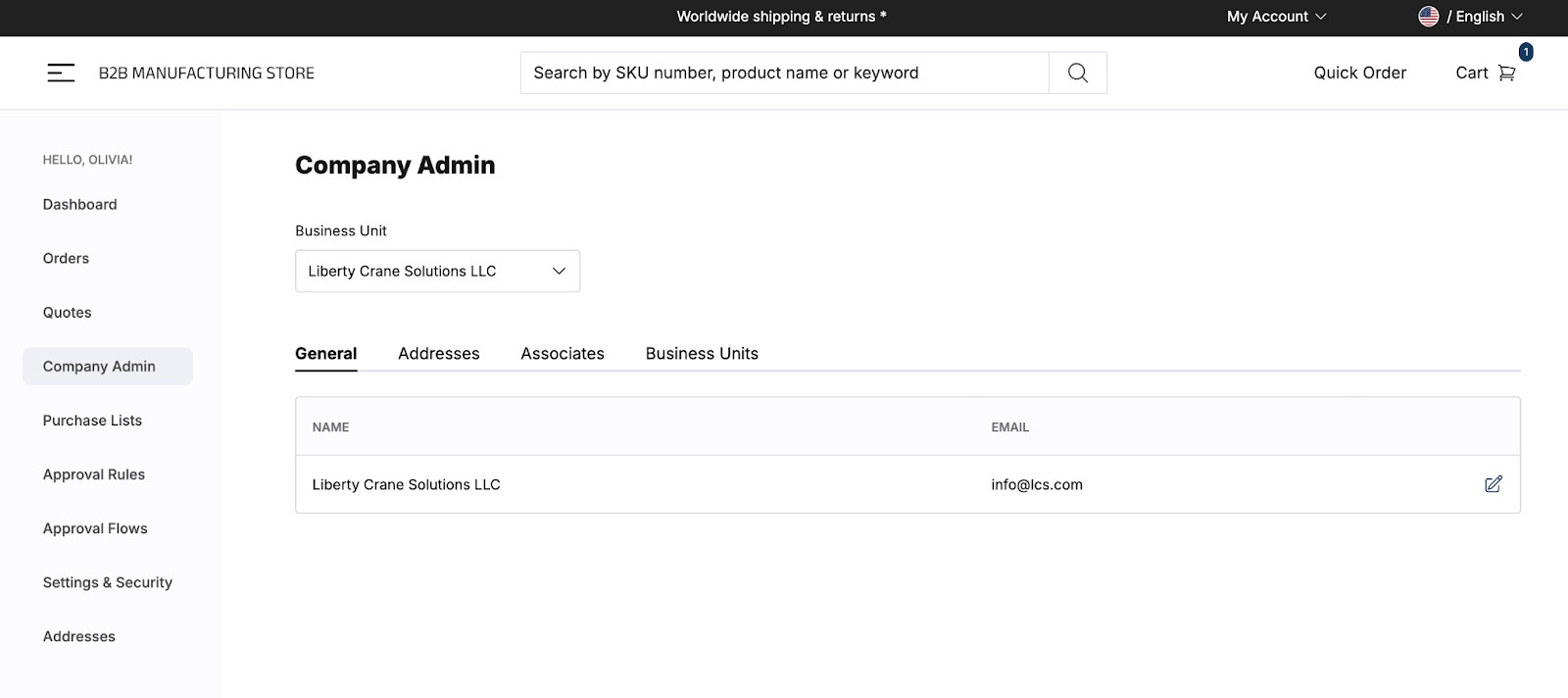
Allow your business customers to buy from your eCommerce store with granular and configurable roles, buyer approval flows and permissions handling based on their organizational requirements.
Within the company admin center, administrators can create and manage approval rules. Associates can view and manage orders that are pending in the approval process under the “Approval Flows” page.
Example: A junior buyer submits a $50K order, which automatically routes to a senior approver before checkout, ensuring compliance with internal policies.
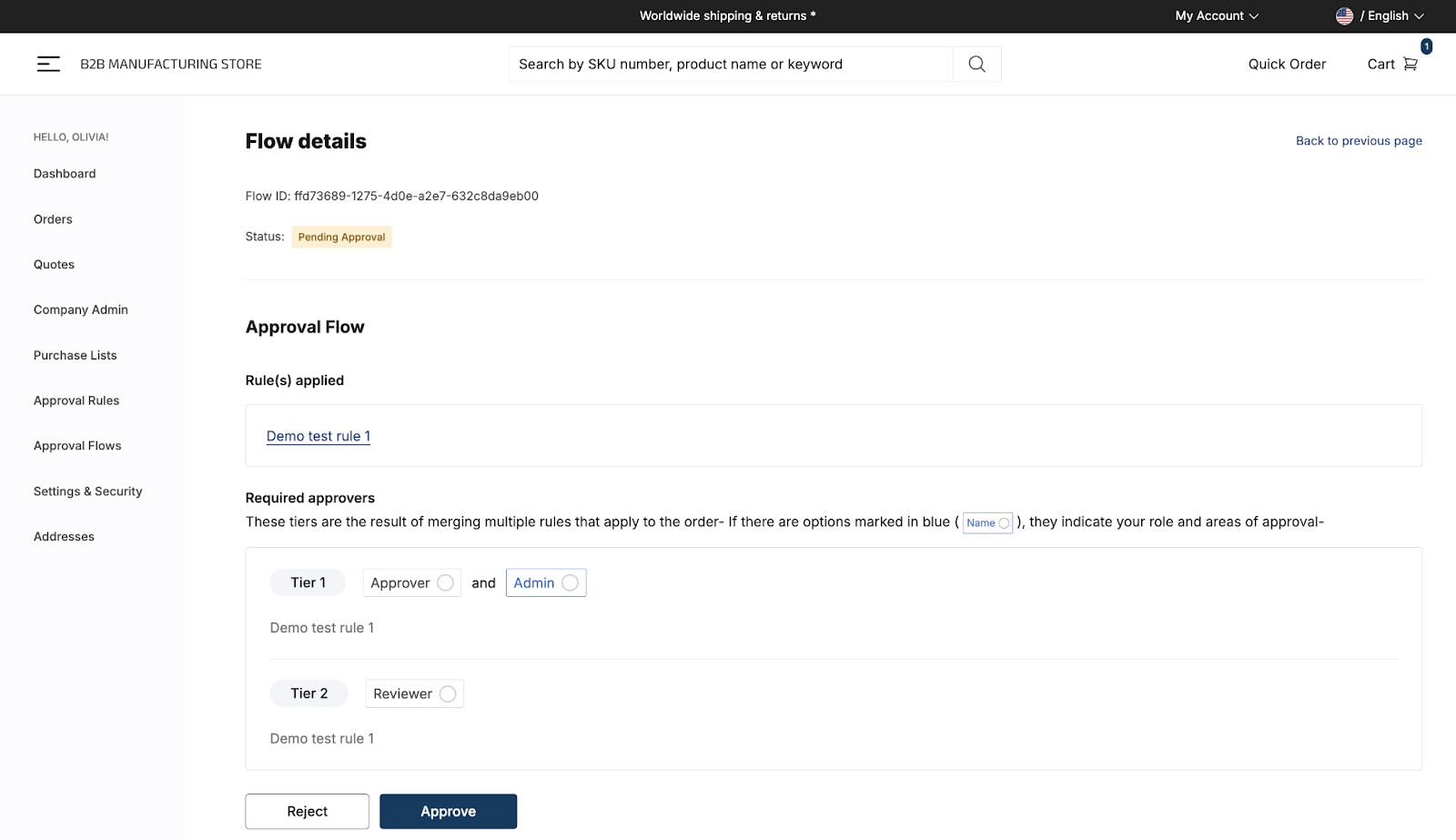
Let customers quickly find desired products, no matter how large your product catalog is. Moreover, the Store Launchpad for B2B Manufacturing comes with a Business Unit-scoped product search, which means products, prices and discounts in the search results are based on the selected Business Unit and Store.
Example: An enterprise buyer sees contract pricing and negotiated discounts in search results, while a reseller logging into their storefront only sees standard wholesale tiers.
Adjust visible Products, Prices and Discounts based on Business Units and Stores. Plus, ensure buyers see relevant products, pricing and promotions depending on their Business Unit or store.
Example: A North American business unit views a catalog that includes region-specific SKUs and promotions, while the European unit accesses a different catalog aligned to EU compliance requirements.
Buyers can easily generate, review, track status, return and reorder. At the same time, sellers can view orders and change status in real-time on commercetools’ business tooling, the Merchant Center. Sellers can access a simple checkout flow with step-by-step guidance to finalize the purchase seamlessly.
Example: A buyer quickly reorders monthly consumables from their purchase list, while a seller updates delivery timelines directly in the order status for full transparency.
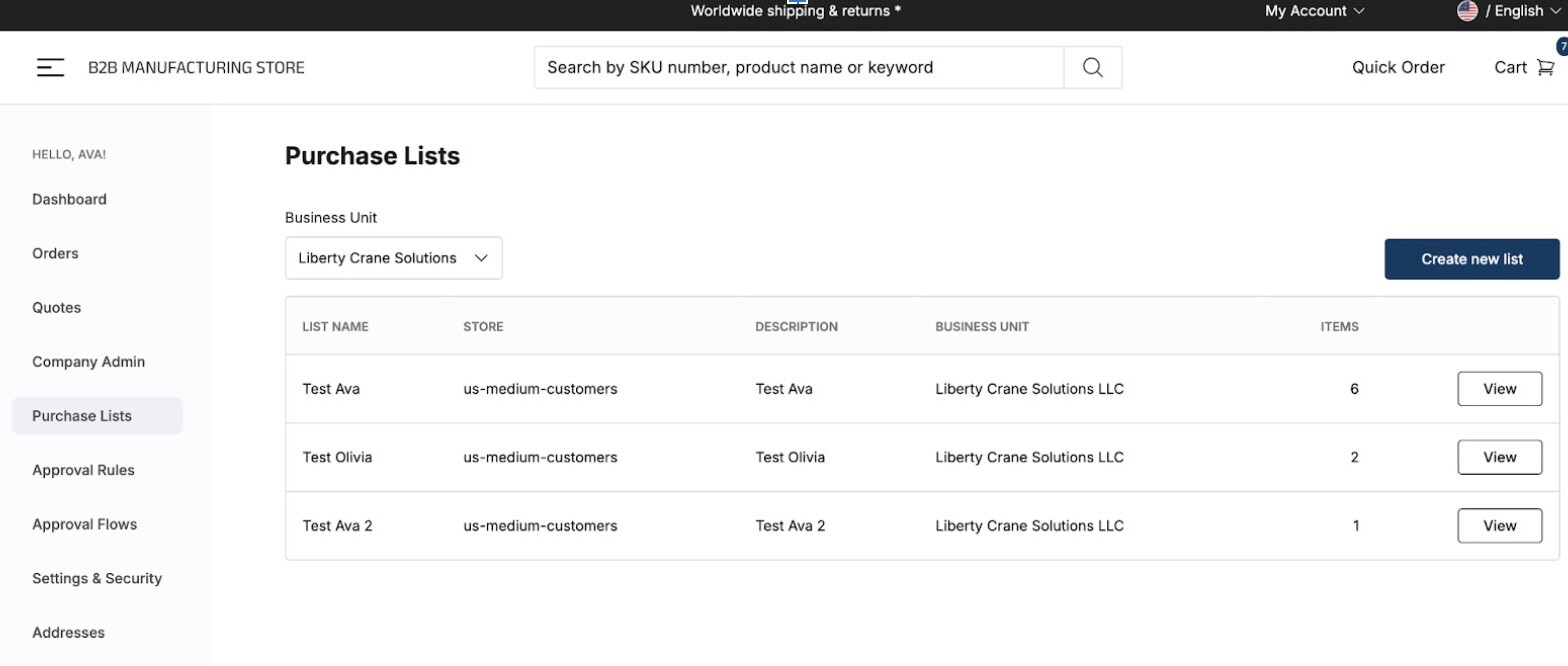
Businesses can model and reflect existing sales and quoting processes, including quote generation, negotiation and acceptance. In addition, with platform capabilities like Eventing, companies can configure notifications triggered by specific actions — for example, alerting a sales rep when a new quote request is submitted or notifying a buyer when a revised quote is ready. This ensures that both buyers and sellers stay aligned throughout the quoting journey, reducing delays and keeping the process transparent.
Example: A buyer requests a quote for 500 units of a custom part, negotiates pricing with the seller, and then converts the approved quote directly into an order.
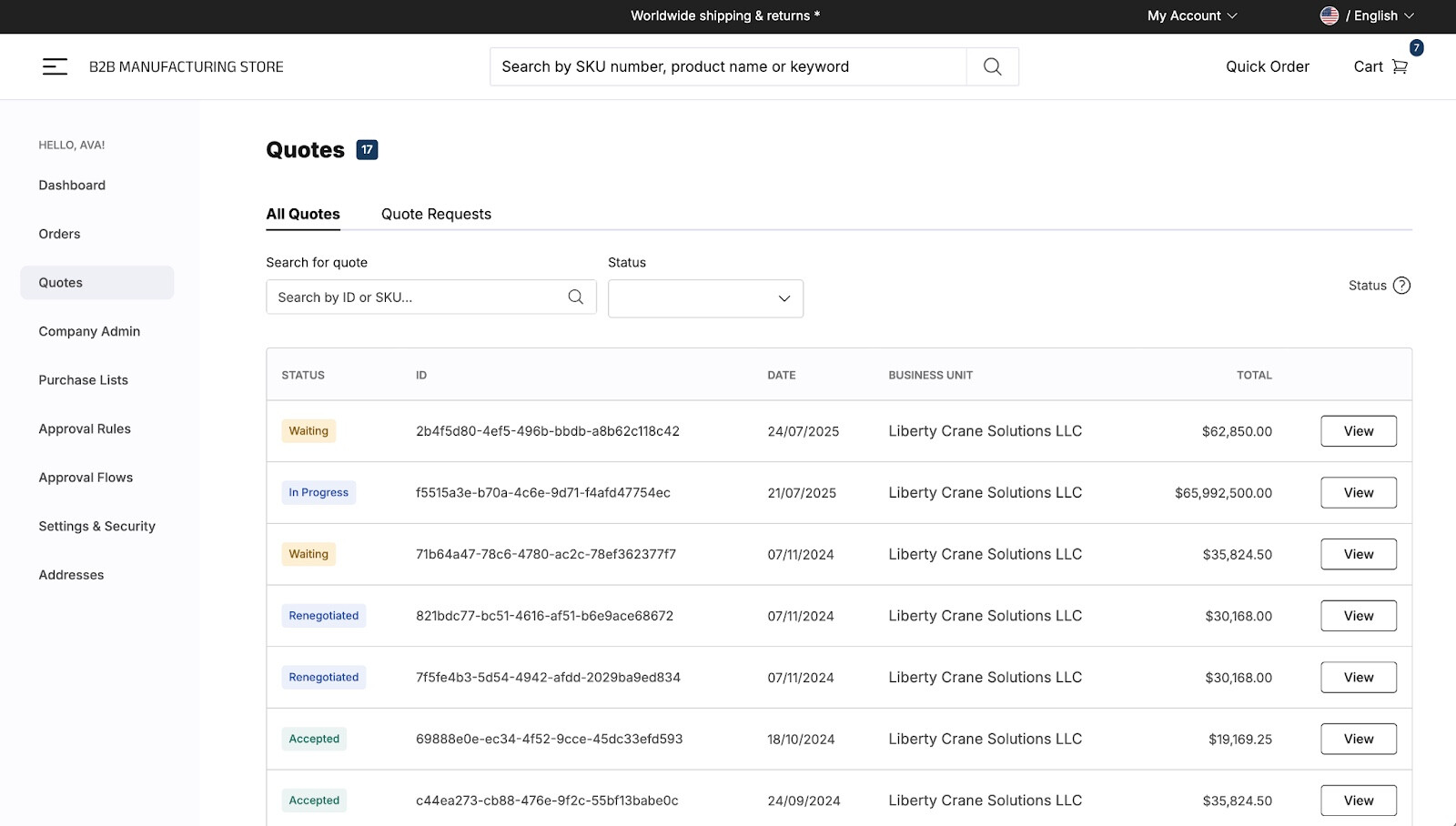
Extensibility for your custom eCommerce storefront
While the Store Launchpad for B2B Manufacturing provides a foundational starting point, you’re not confined by its initial setup. As buyer expectations evolve, the Store Launchpad gives you a fully customizable and functional base from which to develop and adapt your digital storefronts over time, aligning them with your unique brand identity and business requirements.
Store launchpads serve as foundational templates that you can customize, extend or use as is. Because every project is unique, you can use the full store launchpad or only some components, depending on your needs.
Even if you are planning to build a completely custom commerce website, store launchpads can help you understand how to work with commercetools Composable Commerce and Frontend as they outline the best practices for developing Frontend components, extensions and modelling your data.
Ways to get started
The Store Launchpad for B2B Manufacturing serves as an accelerator for your project, offering ready-to-use codebases that significantly reduce your time to market. Using UX/UI best practices, the Store Launchpad ensures easy access to a seamless and engaging shopping experience for your buyers.
There are two ways your business can get started:
commercetools Foundry for B2B Manufacturing: This pre-composed solution combines commercetools B2B Commerce, Frontend and Connect, providing the core capabilities to jumpstart your commerce project. The Store Launchpad is one of the components of this solution.
commercetools B2B Commerce and Frontend: Tap into the sample data we provide in the Store Launchpad to explore realistic commerce scenarios in an example shop, such as heavy machinery and spare parts for B2B manufacturing. This allows you to quickly experience what it’s like using commercetools from the OOTB capabilities of the Store Launchpad, and see how B2B Commerce works seamlessly with commercetools Frontend.
No matter which path you choose to get started, you can experience the full power and speed of composable with our 60-day free trial. The trial gives you access to all the core commerce and B2B-specific APIs, as well as the Store Launchpad with sample data — so you can try it all out, risk-free.
Ready to try it out? Start your free trial and discover how the Store Launchpad for B2B Manufacturing can accelerate your eCommerce storefront rollout.